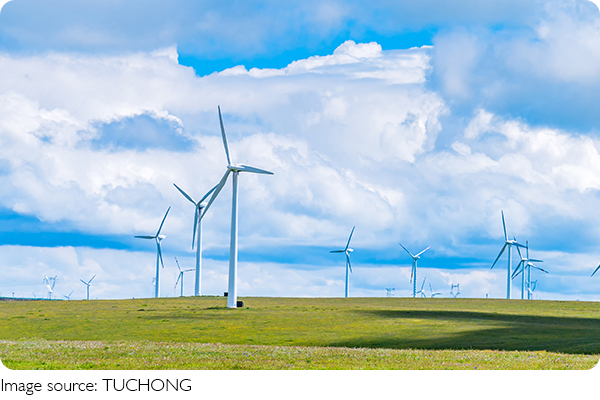Renewable Energy Revolution

Imagine waking up to the sound of wind rustling through trees, the sun shining brightly through your windows, and knowing that the energy you're using to power your home comes from these very natural sources.
This is the potential of renewable energy, and it's no longer just a far-off dream.
Wind, solar, and hydroelectric power are changing the way we think about energy, making it cleaner, more sustainable, and better for the planet. But how exactly do these energy sources work, and why should we care about them? Let's break it down.
Wind Power: Harnessing the Breeze
Wind power is one of the most promising sources of renewable energy. It's been used for centuries, from sailing ships to grain mills, but its modern use as electricity generation is a game-changer. Wind turbines are designed to capture the kinetic energy of the wind and convert it into electrical power.
1. How Wind Turbines Work: The blades of a wind turbine are shaped to catch the wind, causing them to spin. This spinning motion is connected to a generator, which converts the mechanical energy into electrical energy. The stronger the wind, the more electricity can be generated.
Example: In the U.S., Texas has become a leader in wind energy, with over 30,000 megawatts of wind capacity, enough to power millions of homes.
2. Environmental Benefits: Wind energy is clean, meaning it doesn't produce harmful emissions like coal or natural gas. Once a wind turbine is built, it can produce power for decades without releasing greenhouse gases, making it a key player in the fight against climate change.
Example: The world's largest offshore wind farm, located off the coast of the U.K., can generate enough electricity to power over 1 million homes every year.
Solar Power: Harnessing the Sun's Rays
Solar energy is the most abundant source of renewable energy. Every hour, the sun beams enough energy to the Earth to power the entire world for a year. Solar panels, or photovoltaic (PV) cells, capture this energy and convert it into electricity.
1. How Solar Panels Work: Solar panels are made up of many individual cells that capture sunlight and generate an electric current. When sunlight hits the panels, it excites electrons in the material (usually silicon), which creates electricity that can be used immediately or stored in batteries for later.
Example: In California, solar panels are being installed on homes at an increasing rate, with solar power accounting for around 14% of the state's total energy use.
2. Advantages of Solar Power: One of the biggest advantages of solar energy is that it can be generated almost anywhere—from the rooftops of homes to vast solar farms in deserts. Solar panels require very little maintenance, and once installed, they can last 25 years or more, providing a reliable, renewable source of energy.
Example: The world's largest solar power plant, located in the Mojave Desert, generates 550 megawatts of power, enough to supply 200,000 homes.
Hydropower: Power from Water
Hydropower, or hydroelectric energy, is one of the oldest and most widely used sources of renewable energy. By capturing the power of moving water—whether from rivers, dams, or waterfalls—hydropower generates electricity in a consistent and reliable way.
1. How Hydropower Works: A dam stores water at a high elevation, and when the water is released, it flows through turbines, causing them to spin. This mechanical energy is then converted into electricity by a generator. The amount of power produced depends on the volume of water and the height from which it falls.
Example: The Three Gorges Dam in the Yangtze River region is the world's largest hydroelectric plant, with a capacity of over 22,000 megawatts, providing power to millions of people.
2. Benefits and Challenges: Hydropower is incredibly efficient, with some plants operating at over 90% efficiency. However, it can also disrupt local ecosystems, especially in areas where large dams are built. Fish migration, for example, can be impacted by the dams. As a result, some modern hydropower plants are being designed with fish-friendly solutions.
Example: In Canada, the James Bay Project uses a series of dams to provide energy to large regions, but it has also faced environmental concerns related to local wildlife habitats.
The Future of Renewable Energy
The transition to renewable energy is already underway, and the potential for wind, solar, and hydropower to meet the world's energy demands is enormous. However, there are challenges, too. These include storage solutions (such as battery technology) to manage the intermittent nature of wind and solar energy, and balancing environmental impact with the need for power.
1. Innovations in Storage: One of the biggest obstacles for renewable energy is storage. Wind and solar power are intermittent—meaning they don't always generate electricity when demand is highest. Advances in battery technology are helping to solve this issue by storing excess energy for later use.
Example: Tesla's Powerwall system allows homeowners to store solar energy during the day and use it at night, making solar power more reliable and efficient.
2. Global Shift Toward Renewables: Many countries are setting ambitious goals to reduce carbon emissions by investing in renewable energy. For instance, the European Union has set a target to be carbon-neutral by 2050, relying heavily on wind, solar, and hydropower.
Example: In Denmark, wind power accounts for over 40% of the country's electricity consumption, proving that renewable energy can be both reliable and scalable.

Moving Toward a Sustainable Future
Wind, solar, and hydropower offer immense potential to reduce our reliance on fossil fuels and mitigate climate change. The future of energy lies in these renewable resources, and as technology advances, the challenges of storage, efficiency, and environmental impact will continue to improve.
Transitioning to renewable energy is not just about cleaner power; it's about creating a more sustainable world for future generations. By embracing these energy sources, we take one step closer to a future where energy is both abundant and eco-friendly. The change is already happening—now it's up to us to continue pushing forward.

 · Astronomy Team
· Astronomy Team